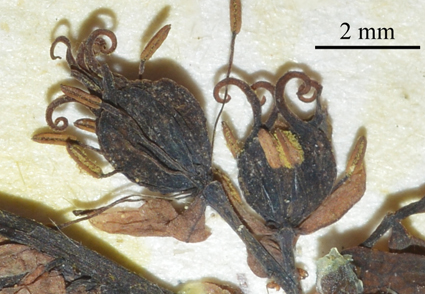Abstract
Based on critical observations on both herbarium specimens (including type material) and living plants in the wild, we demonstrate that Thalictrum spiristylum, described from northwestern Yunnan, China, is conspecific with T. atriplex, a Chinese species widely distributed in southwestern Qinghai, western Sichuan, northwestern Yunnan, and southeastern Xizang. We therefore reduce T. spiristylum to the synonymy of T. atriplex. Morphological distinction between T. atriplex and T. uncatum is clarified. Lectotypification is also proposed for T. atriplex.
References
Boivin, B. (1944) American Thalictra and their old world allies. Rhodora 46: 337–377.
Finet, A.E. & Gagnepain, F. (1903) Contributions a la flore de l’Asie orientale d’aprés l’herbier du muséum de Paris. Bulletin de la Société Botanique de France 50: 600–625. https://doi.org/10.1080/00378941.1903.10831058
Franchet, A. (1889?1890) Plantae Delavayanae. Paul Klincksieck, Paris, 240 pp. https://doi.org/10.5962/bhl.title.10529
Fu, D.Z. & Zhu, G.H. (2001) Thalictrum Linnaeus. In: Wu, Z.Y., Raven, P.H. & Hong, D.Y. (Eds.) Flora of China, vol. 6. Science Press, Beijing & Missouri Botanical Garden Press, St. Louis, pp. 282–302.
Grierson, A.J.C. (1984) Ranunculaceae. In: Grierson, A.J.C. & Long, D.G. (Eds.) Flora of Bhutan, vol. 1, part 2. Royal Botanical Garden, Edinburgh, London, pp. 283?321.
Handel-Mazzetti, H. (1931) Ranunculaceae. In: Symbolae Sinicae, vol. 7. Julius Springer, Wien, pp. 265–321.
Hara, H. (1979) Ranunculaceae. In: Hara, H. & Williams, L.H.J. (Eds.) An Enumeration of the Flowering Plants of Nepal, vol. 2. British Museum (Natural History), London, pp. 9–23.
Linnaeus, C. (1753) Species Plantarum. Laurentii Salvii, Holmiae, 1200 pp.
Marquand, C.V.B. (1929) The botanical collection made by Captain F. Kingdon Ward in the eastern Himalaya and Tibet in 1924–1925. Journal of the Linnean Society of London, Botany 48: 149–229. https://doi.org/10.1111/j.1095-8339.1929.tb00587.x
Maximowicz, C.J. (1890) Plantae chinenses Potaninianae nec non Piasezkianae. Trudy Imperatorskago S.-Peterburgskago Botani?eskago Sada 11: 1–112.
McNeill, J. (2014) Holotype specimens and type citations: General issues. Taxon 63: 1112?1113. https://doi.org/10.12705/635.7
Prantl, K. (1887) Beiträge zur Morphologie und Systematik der Ranunculaceen. Botanische Jahrbücher für Systematik, Pflanzengeschichte und Pflanzengeographie 9: 225–273.
Press, J.R., Shrestha, K.K. & Sutton, D.A. (2000) Ranunculaceae. In: Annotated Checklist of the Flowering Plants of Nepal. The Natural History Museum, London, pp. 248?258.
Turland, N.J., Wiersema, J.H., Barrie, F.R., Greuter, W., Hawksworth, D.L., Herendeen, P.S., Knapp, S., Kusber, W.-H., Li, D.-Z., Marhold, K., May, T.W., McNeill, J., Monro, A.M., Prado, J., Price, M.J. & Smith, G.F. (2018) International Code of Nomenclature for algae, fungi, and plants (Shenzhen Code). Regnum Vegetabile 159. Koeltz Botanical Books, Glashütten, 254 pp. https://doi.org/10.12705/Code.2018
Wang, W.T. (1980) Notulae de Ranunculaceis sinensibus (IV). Bulletin of Botanical Laboratory of North-Eastern Forestry Institute 8: 15–38.
Wang, W.T. (1982) Thalictrum L. In: Wang, W.T. (Ed.) Iconographia Cormophytorum Sinicorum, suppl. 1. Science Press, Beijing, pp. 410?431.
Wang, W.T. (1985) Thalictrum L. In: Wu, C.Y. (Ed.) Flora Xizangica, vol. 2. Science Press, Beijing, pp. 63?76.
Wang, W.T. (1993) Thalictrum L. In: Wang, W.T., Wu, S.G., Lang, K.Y., Li, P.Q., Pu, F.T. & Chen, S.K. (Eds.) Vascular Plants of the Hengduan Mountains, vol. 1. Science Press, Beijing, pp. 495?505.
Wang, W.T. (2000a) Thalictrum L. In: Wu, Z.Y. (Ed.) Flora Yunnanica, vol. 11. Science Press, Beijing, pp. 153–177.
Wang, W.T. (2000b) Thalictrum L. In: Fu, L.K. & Hong, T. (Eds.) Higher Plants of China, vol. 3. Qingdao Publishing House, Qingdao, pp. 459?481.
Wang, W.T. (2017) Six new species of Thalictrum (Ranunculaceae) from China. Guihaia 37: 675–684.
Wang, W.T. (2018) Thalictrum (Ranunculaceae) in China. Peking University Press, Beijing, 376 pp.
Wang, W.T. & Liu, B. (2016) Ranunculaceae. In: Wang, W.T. & Liu, B. (Eds.) Higher Plants of China in Colour, vol. 3. Science Press, Beijing, pp. 332?451.
Wang, W.T. & Wang, S.H. (1979a) Addenda. In: Anonymous (Ed.) Flora Reipublicae Popularis Sinicae, vol. 27. Science Press, Beijing, pp. 603–622.
Wang, W.T. & Wang, S.H. (1979b) Thalictrum L. In: Anonymous (Ed.) Flora Reipublicae Popularis Sinicae, vol. 27. Science Press, Beijing, pp. 502–592.
Wu, C.Y. (1984) Index Florae Yunnanensis, vol. 1. Yunnan People’s Publishing House, Kunming, 1070 pp.
Wu, Y.H. (2008) The Vascular Plants and Their Eco-Geographical Distribution of the Qinghai-Tibetan Plateau. Science Press, Beijing, 1369 pp.
Xie, L., Wang, Z.T., Liu, Q., Li, S.M., Li, Y.S., Song, R.K., Zhao, S.M., Han, L.T., Wang, W., Yu, L., Qian, J.S., Yang, X.W., Zhang, Y.T., Qiao, X., Yang, X.B., Cong, X., Ma, T., Dong, S.Z., Wang, A.N., He, Z.Y. & Pei, J. (2016) Thalictrum L. In: Wei, F.N., Wang, Z.T., Zhang, W.S., Pei, J. & Yang, X.W. (Eds.) Medical Flora of China, vol. 3. Peking University Medical Press, Beijing, pp. 231?287.
Zeng, Y.P., Yuan, Q. & Yang, Q.E. (2018) Reinstatement of the independent specific status of Thalictrum hamatum (Ranunculaceae), with T. macrorhynchum reduced to its synonymy. Phytotaxa 369: 278?286. https://doi.org/10.11646/phytotaxa.369.4.5
Zeng, Y.P., Yuan, Q. & Yang, Q.E. (2021a) Thalictrum jilongense and T. tenuicaule (Ranunculaceae), described from China, are both merged with T. leuconotum. Phytotaxa 509: 168?184. https://doi.org/10.11646/phytotaxa.509.2.2
Zeng, Y.P., Yuan, Q. & Yang, Q.E. (2021b) Thalictrum fusiforme (Ranunculaceae), described from southeastern Xizang (Tibet), China, is merged with T. rostellatum, a Sino-Himalayan species. Phytotaxa (in review).
Zhou, L.H. (1997) Ranunculaceae. In: Zhou, L.H. & Huang, R.F. (Eds.) Flora Qinghaica (“Qinghaiica”), vol. 1. Qinghai People’s Publishing House, Xining, pp. 288?370.


